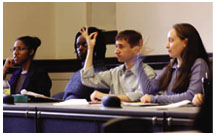November 7, 2001: On the Campus
Language
without sound
Princeton offers sign language for the first time
By Liriel Higa ’02
 Caption:
Princeton’s new not-for-credit classes in American Sign Language
are conducted solely in sign. (Photo: Ricardo Barros)
Caption:
Princeton’s new not-for-credit classes in American Sign Language
are conducted solely in sign. (Photo: Ricardo Barros)
Princeton offers its students an enormous range of language classes, from traditional favorites such as French, Spanish, German, Italian, and Latin, to tongues such as Turkish, Arabic, Hebrew, Chinese, and Japanese. This year, for the first time, Princeton is also offering a comprehensive American Sign Language (ASL) class. The comprehensive class meets two hours each week and has homework.
Unlike the other foreign languages, however, this class is not for credit, so all the students taking the course are doing so purely for their own edification. The teachers come from the nearby Katzenbach School for the Deaf, with which Princeton has had an informal relationship for some years, as Princeton students often go there to tutor deaf students.
The reasons for Princeton students’ interest in ASL are varied: One student is deaf, another wants to become an ASL interpreter, another wants to become an educator, and many are just intrigued. According to one of the Katzenbach teachers, ASL is the one of the top five most utilized languages in the U.S.
Instructors and students hope the classes will be offered for credit one day. After all, many similar institutions such as Brown and Georgetown University offer classes or grant credit for ASL classes taken elsewhere. There is no doubt that the demand exists; last spring, students presented Howard Dobin, associate dean of the college, with hundreds of signatures advocating a comprehensive sign language class. Dobin found the funds for the class, but one of the reasons the request was successful was that credit for the class was not one of the demands. A for-credit class would require a department willing to host the class, approval from President Tilghman, and the funds for a professor, which would cost significantly more than what the university currently pays for the total five hours per week from certified instructors from Katzenbach.
Due to continuing demand this fall, Dean Dobin agreed to fund a second intensive class in conjunction with the Student Volunteers Council. My section is taught by Alyssa Wengel, who has been deaf from birth. She explained on the first day of class that she regards deafness not as a disability, but as a culture. Just as sign language has its own grammar and syntax, so deaf culture comes with its own rules and etiquette. There are rules on how to get someone’s attention (wave at her or, if she is nearby, touch her arm, but never her head). I had gotten some earlier insights into deaf culture when I spent a summer living at Gallaudet University, the only university for the deaf in the world, while I was working on Capitol Hill. There are lights outside each dorm room at Gallaudet, a visual doorbell to grab the occupant’s attention. When a deaf friend invited me to the movies, it took me a while to understand why he was checking out the foreign language selection — it was because of the English subtitles.
President Tilghman has spoken of the need to attract more students from a variety of backgrounds, using “green hair” as a metaphor for students who think a little differently. The Wythes Committee, which recommended increasing the undergraduate student body by five hundred, characterized the increase as an opportunity to “further strengthen the diversity and the intellectual quality of each class.”
Currently, there is only one
deaf undergraduate student and one graduate student at Princeton. Considering
the many hurdles every student must leap to gain admission to Princeton,
their enrollment here is particularly notable. Perhaps as one of the spillover
effects of this sign language class Princeton will attract more individuals
with disabilities. Stay tuned. ![]()
Liriel Higa ’02 is a Woodrow Wilson School major from Los Angeles.
